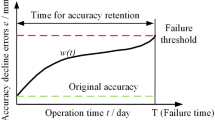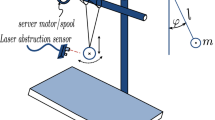Abstract
Double-plane grinding plays an important role in the processing of high-precision flat parts. A double-side autonomous grinding (DSAG) method was proposed and investigated to improve the uniformity of the abrasive grains of the grinding disc on the surface of the workpiece by releasing the constraints on the workpiece. In DSAG, the main driving force of workpiece movement comes from the friction force generated by the relative movement of the upper and lower grinding pads. Experiment of dynamic friction coefficient measurement between workpiece and grinding plates is carried out to take into account the differences of dynamic friction factor under different speed and force conditions. A mathematical model of the relative motion trajectory between the particles on the upper and lower plate and the workpiece is established based on kinematics and dynamics theories. Then, the effects of the linkage mode of the lower plate, grinding pressure, and speed ratio of the upper and lower plates on the frequency and direction uniformity of the grinding trajectory of the abrasive particles on the workpiece surface are simulated and analyzed. Aiming at the trajectory uniformity, the grinding parameters are optimized through orthogonal experiment and verified on the independently developed experimental platform. The flatness and roughness of the workpiece are detected. The results show that the DSAG performs well in obtaining the better roughness and flatness of the workpiece surface than that of planetary grinding.


















Similar content being viewed by others
Data availability
The datasets used or analyzed during the current study are available from the corresponding author on reasonable request.
References
Li ZC, Pei ZJ, Fisher GR (2006) Simultaneous double side grinding of silicon wafers: a literature review. Int J Mach Tools Manuf 46(12–13):1449–1458
Cho BJ, Kim HM, Manivannan R, Moon DJ, Park JG (2013) On the mechanism of material removal by fixed abrasive lapping of various glass substrates. Wear 302(1–2):1334–1339
Kim HM, Park GH, Seo YG, Moon DJ, Cho BJ (2015) Comparison between sapphire lapping processes using 2-body and 3-body modes as a function of diamond abrasive size. Wear 332–333:794–799
Pyun HJ, Purushothaman MC, Chou BJ, Lee JH (2018) Fabrication of high performance copper-resin lapping plate for sapphire: a combined 2-body and 3-body diamond abrasive wear on sapphire. Tribol Int 120:203–209
Barylski A, Piotrowski N (2019) Non-conventional approach in single-sided lapping process: kinematic analysis and parameters optimization. Int J Adv Manuf Technol 100:589–598
Chang KY, Song YH, Lin TR (2002) Analysis of lapping and polishing of a gauge block. Int J Adv Manuf Technol 20(6):414–419
Wang L, Hu Z, Fang C, Yu YQ, Xu XP (2018) Study on the double-sided grinding of sapphire substrates with the trajectory method. Precis Eng 51:308–318
Li Z, Deng Z et al (2020) Effects of polishing parameters on surface quality in sapphire double-sided CMP. Ceram Int 46(9):13356–13364
Satake U, Enomoto T, Keitaro FJ, Kenji H (2016) Optimization method for double-sided polishing process based on kinematical analysis. Procedia CIRP 41:870–874
Pan J, Yan Q, Xu XP, Zhu JT, Wu ZC, Bai ZW (2012) Abrasive particles trajectory analysis and simulation of cluster magnetorheological effect plane polishing. Phys Procedia 25(22):176–184
Sousa F, Hosse DS, Reichenbach I, Auricha JC, Seewig J (2013) Influence of kinematics and abrasive configuration on the grinding process of glass. J Mater Process Tech 213(5):728–739
Fang C, Liu C, Zhao ZX, Lin YF, Hu Zw XuXP (2018) Study on geometrical patterns of textured fixed-abrasive pads in sapphire lapping based on trajectory analysis. Precis Eng 53:169–178
Vainer L, Gamolya U (2020) Analysis and modeling of workpieces’ kinematic in the process of two-sided face grinding[J]. Mater Today: Proc https://doi.org/10.1016/j.matpr.2020.08.292
Danilo CM, Beaudoin S (2003) A locally relevant prestonian model for wafer polishing. J Electrochem Soc 150(2):G96–G102
Fang C, Zhao Z, Lu L, Lin Y (2016) Influence of fixed abrasive configuration on the polishing process of silicon wafers. Int J Adv Manuf Technol 88(1–4):575–584
Kasai T (2008) A kinematic analysis of disk motion in a double sided polisher for chemical mechanical planarization (CMP). Tribol Int 41(2):111–118
Vainer L, Gamolya U (2021) Analysis and modeling of workpieces’ kinematic in the process of two-sided face grinding. Mater Today Proc 38:1794–1798
Li Q, Xiu S, Yao Y, Sun C, Zheng S (2020) Study on surface material removal uniformity in double side grinding based on grain trajectories. Int J Adv Manuf Technol 107(5):2865–2873
Milena K, Michal R, Marta H, Jan V, Roman D, Jan K, Zuzana P (2019) A new way of measuring the belt friction coefficient using a digital servomotor. Measurement 150:107100–107100
Zhao S, Schneider HC, Kamlah M (2020) An experimental method to measure the friction coefficients between a round particle and a flat plate. Powder Technol 361:983–989
Fang XD, Li CS, Sun L, Sun H, Jiang ZD (2020) Hardness and friction coefficient of fused silica under scratching considering elastic recovery. Ceram Int 46(6):8200–8208
Fang YF, Ma LR, Luo JB (2020) Modelling for water-based liquid lubrication with ultra-low friction coefficient in rough surface point contact. Tribol Int 141:105901
Han CF, Wu CC, Chu HY, Tsai PH, Horng JH, Wei CC, Hwang YC, Lin JF (2020) Uses of empirical mode decomposition and multi-entropy techniques to establish the correlations among vibrations, friction coefficients and component wear of ball-bearing-like specimens. Measurement 150:107021
Kim HM, Manivannan R, Moon DJ, Xiong HL, Park JG (2013) Evaluation of double sided lapping using a fixed abrasive pad for sapphire substrates. Wear 302(1–2):1340–1344
Ozturk S, Aydin L, Kucukdogan N, Celik E (2018) Optimization of lapping processes of silicon wafer for photovoltaic applications. Sol Energy 164(APR.):1–11
Funding
This work was supported by the Shaanxi Province key projects (grant number 2017ZDXM-GY-133).
Author information
Authors and Affiliations
Contributions
Nina Wang performed the analysis and summary of the experimental data and was a major contributor in writing the manuscript. Lijuan Ren and Yongchang Li participate in carrying out grinding experiments. All the authors read and approved the final manuscript.
Corresponding author
Ethics declarations
Ethical approval
All data in this paper comes from machining grinding experiments and does not involve ethical issues.
Consent to participate
Not applicable.
Consent for publication
Not applicable.
Competing interests
The authors declare no competing interests.
Additional information
Publisher's note
Springer Nature remains neutral with regard to jurisdictional claims in published maps and institutional affiliations.
Rights and permissions
Springer Nature or its licensor (e.g. a society or other partner) holds exclusive rights to this article under a publishing agreement with the author(s) or other rightsholder(s); author self-archiving of the accepted manuscript version of this article is solely governed by the terms of such publishing agreement and applicable law.
About this article
Cite this article
Wang, N., Zhang, G., Ren, L. et al. Modeling and simulation method of trajectory in double-side autonomous grinding considering the dynamic friction coefficient. Int J Adv Manuf Technol 124, 1199–1216 (2023). https://doi.org/10.1007/s00170-022-10473-z
Received:
Accepted:
Published:
Issue Date:
DOI: https://doi.org/10.1007/s00170-022-10473-z




